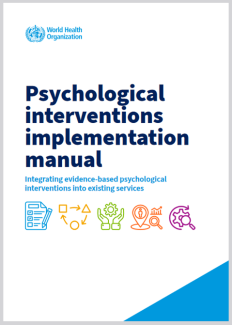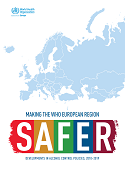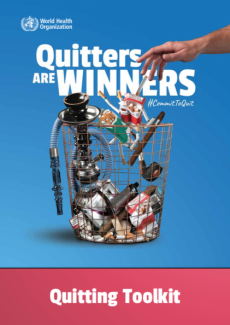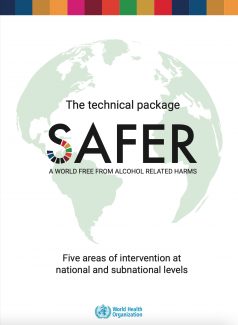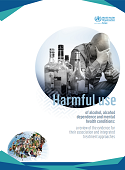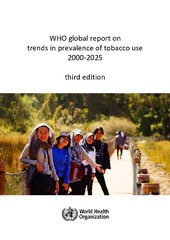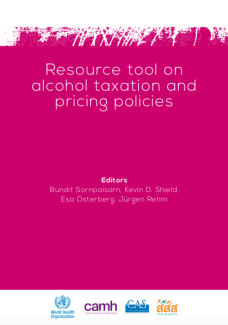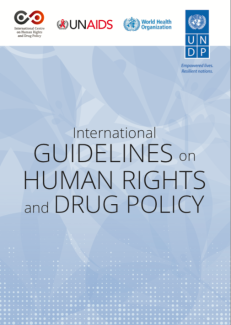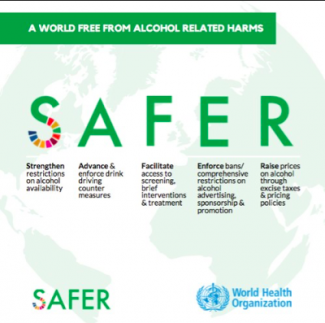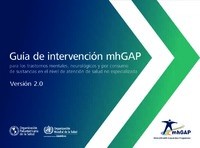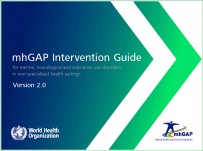Search
WHO stakeholder survey on improving access to morphine for medical use
WHO launched a survey on assessing barriers, enablers, and pirority actions for improving access to morphine for medical use.
All Civil Society Organisation can contribute by filling out the survey before 31 August 2022.
The survey is...
Making the European Region Safer: developments in alcohol control policies, 2010–2019 (2021)
This report presents the current status of alcohol consumption, alcohol-attributable harms and the implementation of alcohol control policies in the WHO European Region, using available data from 2010, 2016 and 2019.
A detailed overview is...
کوویڈ 19 ردعمل: کمیونٹی ہیلتھ ورکرز کے لئے ذہنی صحت اور نفسیاتی مدد
یہ آن لائن کورس اس بات کا جائزہ فراہم کرتا ہے کہ کس طرح کمیونٹی ہیلتھ ورکرز (سی ایچ ڈبلیو) کوویڈ 19 وبائی امراض کے دوران مناسب ذہنی صحت اور نفسیاتی مدد فراہم کرکے اپنی برادریوں کی مدد کرسکتے ہیں۔
اس کورس میں آپ سیکھیں گے کہ کس طرح:
- صح...
Drug overdose: a film about life
WHO Quitting Toolkit
Toolkit for delivering the 5A’s and 5R’s brief tobacco interventions in primary care
Making the European Region Safer: Developments in Alcohol Control Policies, 2010–2019
This report presents the current status of alcohol consumption, alcohol-attributable harms and the implementation of alcohol control policies in the WHO European Region, using available data from 2010, 2016 and 2019.
A detailed overview is...
ترکی کی غیر متعدی بیماریوں کی پالیسی کے اہداف کے حصول کے اثرات کا تخمینہ
ورلڈ ہیلتھ آرگنائزیشن کے مطابق اگر ترکی تمباکو اور نمک کے استعمال میں 30 فیصد اور جسمانی غیر فعالیت میں 10 فیصد کمی لانے کے اپنے موجودہ اہداف کو حاصل کر لیتا تو 2017 میں ترکی میں تقریبا 20 ہزار اموات کو روکا جا سکتا تھا۔
ڈبلیو ایچ او کے...
ڈبلیو ایچ او گائیڈ لائن: صحت کے نظام کو مضبوط بنانے کے لئے ڈیجیٹل مداخلت پر سفارشات
اس گائیڈ لائن کا بنیادی مقصد ابھرتی ہوئی ڈیجیٹل ہیلتھ مداخلتوں پر شواہد کے تنقیدی جائزے پر مبنی سفارشات پیش کرنا ہے جو صحت کے نظام کی بہتری میں حصہ ڈال رہے ہیں ، فوائد ، نقصانات ، قبولیت ، فزیبلٹی ، وسائل کے استعمال اور برابری کے خیالات کی...
How Can Telehealth Help in the Provision of Integrated Care?
The World Health Organisation defines telehealth as:
The use of telecommunications and virtual technology to deliver health care outside of traditional health-care facilities.
Well-designed telehealth schemes can improve health care...
Alcohol Use, Alcohol Dependence and Mental Health Conditions
Several key risk factors for noncommunicable diseases (NCDs) have been identified, including the harmful use of alcohol.
Half the world’s population drinks alcohol, and harmful alcohol use is the third leading cause of ill health and...
WHO Global Report on Trends in Prevalence of Tobacco Use 2000-2025
Tobacco is the only legal drug that kills many of its users when used exactly as intended by manufacturers. WHO has estimated that tobacco use (smoking and smokeless) is currently responsible for the death of about six million people across...
Resource Tool on Alcohol Taxation and Pricing Policies
Alcohol taxation and pricing policies have several public health, economic and social benefits as they have the capacity to:
- Generate tax revenue
- Reduce alcohol consumption and associated harms (covering both externalities and...
UNODC-WHO Joint Programme on Drug Dependence Treatment and Care
Both the WHO and UNODC strive to address the complex issues presented by drug use and dependence.
The vision: The effective and humane treatment for all people with drug use disorders. Nothing less than would be expected for any other...
The International Guidelines on Human Rights and Drug Policy
UNIATF: Call for Nominations for the Task Force Awards 2019
World Health Organization SAFER Alcohol Control Initiative
The WHO Global Status Report on Alcohol and Health claims that alcohol consumption contributes to more than 3 million deaths globally every year and is the seventh leading risk factor for premature death and disability.
The World Health...
غیر ماہر صحت کی دیکھ بھال کی سطح پر ذہنی، اعصابی اور مادہ کے استعمال کی خرابیوں کے لئے ایم ایچ جی اے پی مداخلت کی ہدایات. ورژن 2.0
دماغی، اعصابی اور مادہ کے استعمال کی خرابی (ایم این ایس) بہت عام ہیں اور دنیا بھر میں بیماری اور معذوری کے ایک بڑے بوجھ کی نمائندگی کرتے ہیں. صحت کے نظام کی صلاحیت اور دستیاب وسائل کے درمیان ایک وسیع فرق موجود ہے، جس کی فوری ضرورت ہے اور...
ایم ایچ جی اے پی انٹروینشن گائیڈ - غیر خصوصی صحت کی ترتیبات میں ذہنی، اعصابی اور مادہ کے استعمال کی خرابیوں کے لئے ورژن 2.0
جائزہ
یہ غیر ماہر صحت کی ترتیبات میں ذہنی، اعصابی اور مادہ کے استعمال (ایم این ایس) کی خرابیوں کے لئے ایم ایچ جی اے پی انٹروینشن گائیڈ (ایم ایچ جی اے پی-آئی جی) کا دوسرا ورژن (2016) ہے۔ یہ ڈاکٹروں ، نرسوں ، دیگر صحت کارکنوں کے ساتھ ساتھ...
Share the Knowledge: ISSUP members can post in the Knowledge Share – Sign in or become a member
